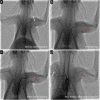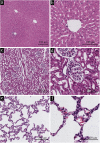Novel Hydrogel Material as a Potential Embolic Agent in Embolization Treatments
- PMID: 27561915
- PMCID: PMC4999878
- DOI: 10.1038/srep32145
Novel Hydrogel Material as a Potential Embolic Agent in Embolization Treatments
Abstract
We report a novel graphene-oxide (GO) enhanced polymer hydrogel (GPH) as a promising embolic agent capable of treating cerebrovascular diseases and malignant tumors, using the trans-catheter arterial embolization (TAE) technique. Simply composed of GO and generation five poly(amidoamine) dendrimers (PAMAM-5), our rheology experiments reveal that GPH exhibits satisfactory mechanical strength, which resist the high pressures of blood flow. Subcutaneous experiments on Sprague-Dawley (SD) rats demonstrate the qualified biocompatibility of GPH. Finally, our in vivo experiments on New Zealand rabbits, which mix GPH with the X-ray absorbing contrast agent, Iohexol, reveal complete embolization of the artery. We also note that GPH shortens embolization time and exhibits low toxicity in follow-up experiments. Altogether, our study demonstrates that GPH has many advantages over the currently used embolic agents and has potential applications in clinical practice.
Figures






Similar articles
-
Dynamic agent of an injectable and self-healing drug-loaded hydrogel for embolization therapy.Colloids Surf B Biointerfaces. 2018 Dec 1;172:601-607. doi: 10.1016/j.colsurfb.2018.09.016. Epub 2018 Sep 10. Colloids Surf B Biointerfaces. 2018. PMID: 30219579
-
A thermoresponsive supramolecular copolymer hydrogel for the embolization of kidney arteries.Biomater Sci. 2016 Oct 18;4(11):1673-1681. doi: 10.1039/c6bm00597g. Biomater Sci. 2016. PMID: 27709136
-
Development of a Short-Term Embolic Agent Based on Cilastatin for Articular Microvessels.Medicina (Kaunas). 2024 Sep 20;60(9):1538. doi: 10.3390/medicina60091538. Medicina (Kaunas). 2024. PMID: 39336578 Free PMC article.
-
Advancements in hydrogel-based embolic agents: Categorized by therapeutic mechanisms.Cancer Med. 2024 Oct;13(20):e70183. doi: 10.1002/cam4.70183. Cancer Med. 2024. PMID: 39440706 Free PMC article.
-
Recent Progress in Advanced Hydrogel-Based Embolic Agents: From Rational Design Strategies to Improved Endovascular Embolization.Adv Healthc Mater. 2023 Jul;12(17):e2202787. doi: 10.1002/adhm.202202787. Epub 2023 Mar 26. Adv Healthc Mater. 2023. PMID: 36905401 Review.
Cited by
-
Emerging Embolic Agents in Endovascular Embolization: An Overview.Prog Biomed Eng (Bristol). 2020 Jan;2(1):012003. doi: 10.1088/2516-1091/ab6c7d. Epub 2020 Feb 12. Prog Biomed Eng (Bristol). 2020. PMID: 34553126 Free PMC article. No abstract available.
-
Photomodulated Extrusion as a Localized Endovascular Hydrogel Deposition Method.Adv Healthc Mater. 2023 May;12(12):e2202632. doi: 10.1002/adhm.202202632. Epub 2023 Feb 3. Adv Healthc Mater. 2023. PMID: 36681868 Free PMC article.
-
OnyxTMGel or Coil versus Hydrogel as Embolic Agents in Endovascular Applications: Review of the Literature and Case Series.Gels. 2024 May 2;10(5):312. doi: 10.3390/gels10050312. Gels. 2024. PMID: 38786229 Free PMC article. Review.
-
In Situ-Forming Polyamidoamine Dendrimer Hydrogels with Tunable Properties Prepared via Aza-Michael Addition Reaction.ACS Appl Mater Interfaces. 2017 Mar 29;9(12):10494-10503. doi: 10.1021/acsami.7b00221. Epub 2017 Mar 15. ACS Appl Mater Interfaces. 2017. PMID: 28263553 Free PMC article.
-
An injectable and dual-crosslinked hydrogel for controlled and permanent vascular embolization.Bioact Mater. 2025 Jul 9;53:141-160. doi: 10.1016/j.bioactmat.2025.06.049. eCollection 2025 Nov. Bioact Mater. 2025. PMID: 40688022 Free PMC article.
References
-
- Heron M. Deaths: leading causes for 2010. Natl Vital Stat Rep. 62, 1–96 (2013). - PubMed
-
- He J. et al.. Major causes of death among men and women in China. N Engl J Med 353, 1124–1134 (2005). - PubMed
-
- Mathers C. D., Boerma T. & Ma Fat D. Global and regional causes of death. Br Med Bull 92, 7–32 (2009). - PubMed
-
- Jiang H. et al.. Antiangiogenic therapy enhances the efficacy of transcatheter arterial embolization for hepatocellular carcinomas. Int J Cancer 121, 416–424 (2007). - PubMed
-
- Fiore F. et al.. Transarterial embolization (TAE) is equally effective and slightly safer than transarterial chemoembolization (TACE) to manage liver metastases in neuroendocrine tumors. Endocrine 47, 177–182 (2014). - PubMed
Publication types
MeSH terms
Substances
LinkOut - more resources
Full Text Sources
Other Literature Sources

